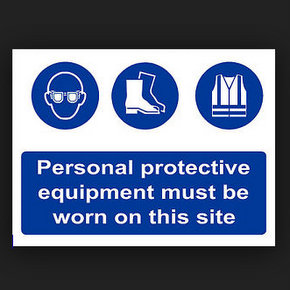
Understanding when to use Personal Protective Equipment (PPE)
 GUEST BLOG: Hannah Spruce looks at what you need to know about PPE, including selecting the right equipment and knowing how to use it. Hannah writes for High Speed Training, an online training provider that offers a wide range of health and safety eLearning courses.
GUEST BLOG: Hannah Spruce looks at what you need to know about PPE, including selecting the right equipment and knowing how to use it. Hannah writes for High Speed Training, an online training provider that offers a wide range of health and safety eLearning courses.
Personal Protective Equipment (PPE)
If your work poses a hazard to you, your employer should have done a risk assessment to reduce those hazards. You might need PPE; you might not.
Think of risk reduction as a scale, with group measures coming first, and PPE as the last measure on that scale.
Group risk reduction comes first because they’re in place to reduce risks for everyone and have the greatest potential to reduce risks.
PPE? That’s the extra cushioning to protect you – the individual – if the worst does happen, or when hazards are unavoidable. But, it only comes out when all other bases are covered; when the scaffolding is up, when the airbags are in place, then that’s when the hard hats come out.
This guide is a brief breakdown of what you need to know about PPE, selecting it and using it.
Know the limitations of PPE
Over Christmas, my brother and I came back to my parents home (hang on, this is relevant). One evening, he used heat resistant gloves to open the stove and add more logs.
But, thinking the gloves were fire-retardant, he decided to rearrange the burning logs.
He came away with the tips of the gloves lightly on fire, and after a moment of flapping he was left with the tips charred.
So, my parent’s got what they always wanted, a pair of DIY fingerless heat protective gloves. Very useful.
But, there’s a valuable lesson to be learnt here: know the limitations of the PPE you use.
That, and, PPE will not make you fireproof, especially if it doesn’t claim to be fireproof on the tin. Note: read the tin. And, get proper training and instruction on how to use your PPE.
- Always use PPE as it is advised and don’t neglect to use it, even if you’re exposed to a hazard for just a few minutes.
- It’s up to employers to pay for PPE and to provide correct instruction on how to use PPE.
When should I be using PPE?
Whenever your work poses a hazard to you, PPE will reduce those risks.
PPE minimises potential risks to your lungs, head, eyes, skin, and body from external harm.
To help you decide what PPE you need to use, imagine the work you’ll be doing and ask yourself:
- What are the hazards that this work will expose me to?
- How long am I exposed to these hazards?
- How much of a hazard does the work pose?
Answering these questions helps you think through what you’ll need to complete your work safely, protecting your body, face and lungs from harm.
Picking your PPE
- Choose CE marked products (or ask the supplier if they are made to the standards of Personal Protective Equipment Regulations 2002).
- Choose PPE that suits you; get the right fit, size, and weight.
- If you need multiple items, make sure that each item doesn’t interfere with another and prevent it from working properly.
And that’s it, you’re good to go.
Latest news

21st February 2025
ASSA ABLOY EMEIA: Save valuable time and money with a seamless switch to programmable digital keys
In 2025, access management can be a whole lot easier. By making access part of their digital processes, businesses can put time-consuming key management and the cost of changing the locks firmly behind them. Making this switch is a lot easier than many people think, as ASSA ABLOY explains here…
Posted in Access Control & Door Entry Systems, Architectural Ironmongery, Articles, Building Industry News, Building Products & Structures, Building Services, Doors, Facility Management & Building Services, Health & Safety, Information Technology, Innovations & New Products, Retrofit & Renovation, Security and Fire Protection
21st February 2025
Showersave supports industry leaders in addressing Part L and Part G regulations
Showersave has sponsored and participated in a recent Building Insights LIVE roundtable on ‘Water & Energy Saving Innovations in New Build Housing’.
Posted in Articles, Bathrooms & Toilets, Bathrooms, Bedrooms & Washrooms, Building Associations & Institutes, Building Industry Events, Building Industry News, Building Products & Structures, Building Regulations & Accreditations, Building Services, Exhibitions and Conferences, Interiors, Pipes & Fittings, Plumbing, Retrofit & Renovation, Sustainability & Energy Efficiency
21st February 2025
GEZE: The importance of Specifying High Quality Door Closers on Fire Doors
Andy Howland, Sales & Marketing Director at GEZE UK, discusses why specifying high quality door closers on fire doors is important…
Posted in Access Control & Door Entry Systems, Accessibility, Architectural Ironmongery, Articles, Building Industry News, Building Products & Structures, Building Regulations & Accreditations, Building Services, Doors, Facility Management & Building Services, Health & Safety, Posts, Restoration & Refurbishment, Retrofit & Renovation, Security and Fire Protection
21st February 2025
Insight Data achieves ISO9001 recertification with zero non-conformities
Leading industry data specialist, Insight Data, has successfully achieved the prestigious recertification for ISO9001 with zero non-conformities for the fourth consecutive year.
Posted in Articles, Building Industry News, Building Regulations & Accreditations, Building Services, Information Technology, Research & Materials Testing
 Sign up:
Sign up: